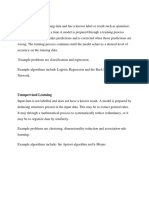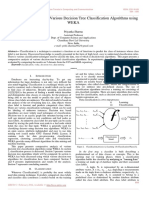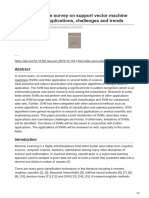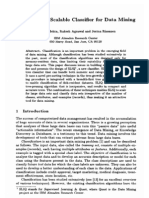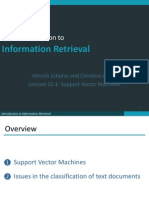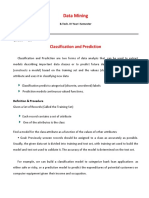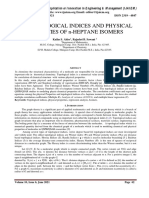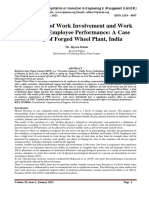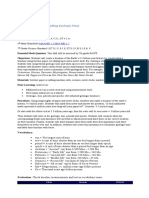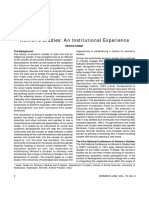0 ratings0% found this document useful (0 votes)
39 viewsA Review of Supervised Learning Based Classification For Text To Speech System
A Review of Supervised Learning Based Classification For Text To Speech System
International Journal of Application or Innovation in Engineering & Management (IJAIEM)
Web Site: www.ijaiem.org Email: editor@ijaiem.org
Volume 3, Issue 6, June 2014 ISSN 2319 - 4847
Copyright:
© All Rights Reserved
Available Formats
Download as PDF, TXT or read online from Scribd
A Review of Supervised Learning Based Classification For Text To Speech System
A Review of Supervised Learning Based Classification For Text To Speech System
0 ratings0% found this document useful (0 votes)
39 views8 pagesInternational Journal of Application or Innovation in Engineering & Management (IJAIEM)
Web Site: www.ijaiem.org Email: editor@ijaiem.org
Volume 3, Issue 6, June 2014 ISSN 2319 - 4847
Original Title
IJAIEM-2014-06-12-30
Copyright
© © All Rights Reserved
Available Formats
PDF, TXT or read online from Scribd
Share this document
Did you find this document useful?
Is this content inappropriate?
International Journal of Application or Innovation in Engineering & Management (IJAIEM)
Web Site: www.ijaiem.org Email: editor@ijaiem.org
Volume 3, Issue 6, June 2014 ISSN 2319 - 4847
Copyright:
© All Rights Reserved
Available Formats
Download as PDF, TXT or read online from Scribd
Download as pdf or txt
0 ratings0% found this document useful (0 votes)
39 views8 pagesA Review of Supervised Learning Based Classification For Text To Speech System
A Review of Supervised Learning Based Classification For Text To Speech System
International Journal of Application or Innovation in Engineering & Management (IJAIEM)
Web Site: www.ijaiem.org Email: editor@ijaiem.org
Volume 3, Issue 6, June 2014 ISSN 2319 - 4847
Copyright:
© All Rights Reserved
Available Formats
Download as PDF, TXT or read online from Scribd
Download as pdf or txt
You are on page 1of 8
International Journal of Application or Innovation in Engineering& Management (IJAIEM)
Web Site: www.ijaiem.org Email: editor@ijaiem.org
Volume 3, Issue 6, June 2014 ISSN 2319 - 4847
Volume 3, Issue 6, June 2014 Page 79
Abstract
Supervised learning technique is one type of machine learning algorithm that creates a function from training data, which
usually consists of pairs of an input object, typical vectors, and a desired output. To classify the features into class labels based on
decision regions by a classifier. This paper discusses the different techniques of supervised learning classifier. One of the
important classification method used in many areas are Support Vector Machine (SVM) classifier. The proposed classifier deals
with large data base and that can be used for categorizing the syllables based on duration.
Keywords: Supervised learning, Support Vector Machine, Classifiers.
1. INTRODUCTION
Machine learning [1] is a scientific discipline that the computer allows to evolve the behaviors from database based on
empirical data, which is concerned with the design and development of algorithms. The main goal of supervised learning
is to get the computer to learn classification system that it has created [2]. Example of classification learning is Digit
recognition. Classification learning is generally more appropriate for any problem and the classification is easy to
determine. The pre-determined classification is not necessary at some instance of classification problems.
The most common technique for training neural networks and decision trees are supervised learning technique. The pre-
determined classification is used by both of those techniques and that are more dependable on the classified information.
In the case of neural networks, the classification is used to determine the error of the network and then adjust the network
to minimize it, and in decision trees, to solve the classification problem to find out which attributes provide more
information for classification.
Supervised learning can generate the two types of models. A global model that maps input set of objects to desired output
set of objects generated by a supervised learning. In some cases, however, the map is implemented as a set of local
models. In order to solve a given problem of supervised learning [2] (e.g. learning to recognize handwriting) one has to
consider various steps:
a. First the type of training example is described. Before starting anything else, we should decide what kind of data is to
be used as an example.
b. After that training set is gathered. The characteristic of the real-world use of the functions needed for the training set.
Thus, input set of objects are gathered and corresponding output objects are also gathered, either from human experts or
from measurements.
c. The representation of the learned function input feature is determined. The learned function accuracy depends strongly
on how the input sets of objects are represented.
d. The structure of the learned function and corresponding learning algorithm is determined.
e. If the design is completed then the user runs the learning algorithm on the gathered training set. The learning
algorithm Parameters may be adjusted by optimizing performance on a subset (called a validation set) of the training set,
or via cross-validation.
Classification is an important task in pattern recognition, machine learning and data mining. The main goal of
classification for each item in the dataset is to predict the target class accurately. Basically in classification there are two
A Review of Supervised Learning Based
Classification for Text to Speech System
P.Sunitha Devi
1
, CH.Sowjanya
2
and K.V.N.Sunitha
3
1
Assistant Professor, Department of CSE, G. Narayanamma Institute of Technology and Science, Hyderabad
2
P.G Scholar, Department of CSE, G. Narayanamma Institute of Technology and Science, Hyderabad
3
Principal, BVRITH for Women,Bachupally, Hyderabad,AP,India
International Journal of Application or Innovation in Engineering& Management (IJAIEM)
Web Site: www.ijaiem.org Email: editor@ijaiem.org
Volume 3, Issue 6, June 2014 ISSN 2319 - 4847
Volume 3, Issue 6, June 2014 Page 80
phases, a training phase and validation phase. In training phase a training set is identified for the construction of a
classifier. Each record in the training set will have several attributes, one of which is the class label attribute which
indicates the class to which that record belongs. The classifier, once built and tested, can be used to predict the class label
of new records that do not yet have a class label attribute value. In the validation phase, a test set is used to test the
correctness of the classifier. The classifier, once tested and certified, can used to predict the class label of unclassified data
in the future. Support vector machine (SVM) is a highly desirable classification method and it is a well known classifier
due to its excellent classification accuracy, generalization and compact model. The largest separation (or margin) between
the two classes are represented by a hyper plane [3]. It minimizes the empirical classification error and maximizes the
geometric margin. However this kind of maximum-margin hyper plane may not exist because of class overlapping or
mislabeled examples. In the linearly separable case the hyper plane is easy to compute, however in the general case it is
necessary to use a soft margin SVM by introducing slack variables. In this way it is possible to find a hyper plane that
splits the examples as clearly as possible. In order to find a separation hyper plane, it is necessary to solve a Quadratic
Programming Problem (QPP). This is computational expensive, it has O (n
3
) time and O (n
2
) space complexities with n
data [4]. So the standard SVM is unfeasible for large data sets [5].
Many researchers have tried to find possible methods to apply SVM classification for large datasets. These methods can
be divided into four types: a) reducing training data sets (data selection) [6], b) using geometric properties of SVM [1],
c) modifying SVM classifiers [7], d) decomposition [5]. The data selection method chooses the objects which are possible
to be the support vectors. These data are used for SVM training. Generally, the number of the support vectors is much
small compared with the whole data. Clustering is another effective tool to reduce data set size, for example, hierarchical
clustering [8] and parallel clustering [9]. The geometric properties of SVM can also be used to reduce the training data.
In separable case, the maximum-margin hyper plane is equivalent to finding the nearest neighbors of each class [10]. The
random sampling method [6] is simple and commonly used for large data sets. However it needs to be applied several
times and the obtained results are not repeatable.
Data selection methods choose objects which are support vectors. These data are used for training the SVM classifier.
Generally, the number of the support vectors is a small subset of the whole data [11]. The goals of this type of method are:
a) fast detection of support vectors which define the optimal separating hyper plane, b) remove the data which are
impossible to be Support Vectors, c) obtain similar accuracy using the reduced data set.
The Decision Tree (DT) classifier is a method that has been used as a preprocessing step for SVM in recent years.
Generally, the classification accuracy of SVM is better than DT.
Different techniques have been discussed for classification, such as Decision trees, Naive Bayesian, Neural networks, K
nearest Neighbours, Radial Basis Function, Gaussian mixture model, Support vector machine etc. Among these models,
Support vector machine models are widely used for classification.When you submit your paper print it in one-column
format, including figures and tables. In addition, designate one author as the corresponding author. This is the author
to whom proofs of the paper will be sent. Proofs are sent to the corresponding author only.
2. CLASSIFICATION METHODS:
2.1 Decision Tree:
Decision tree learning is a method commonly used in data mining. Decision tree is mainly used for classification. It uses
the Divide and conquer strategy. It is an example of machine learning supervised algorithm [12]. Decision tree
classifier is a hierarchical structure where at each level a test is applied to one or more attribute values that may have one
of two outcomes. The outcome may be a leaf, which allocates a class, or a decision node, which specifies a further test on
the attribute values and forms a branch or sub-tree of the tree.
Decision tree is a classifier method able to produce models that can be comprehensible by human experts. Among the
advantages of decision trees over other classification methods are: robustness to noise, ability to deal with redundant
attributes, generalization ability via post-pruning strategy and a low computational cost and the decision trees are trained
using data sets with nominal attributes.
When a data set X is large, the computational burden is heavy. We first use decision tree to separate X into several
subsets. A decision tree is a classifier whose model resembles a tree structure T, this structure is built from a labeled data
set X. A decision tree is composed of nodes, and edges that connect the nodes. There are two type nodes: internal and
terminal. An internal node has branches to connect to other ones, called its sons. A terminal node does not have any sons.
The terminal node is called a leaf L of T.
In order to explain the general training process of decision trees on numeric attributes, lets represent the training data
sets as in (1).
International Journal of Application or Innovation in Engineering& Management (IJAIEM)
Web Site: www.ijaiem.org Email: editor@ijaiem.org
Volume 3, Issue 6, June 2014 ISSN 2319 - 4847
Volume 3, Issue 6, June 2014 Page 81
Such that:
With
X Training set,
A vector that represents an example or object in X,
The category or class of ,
M Number of examples in training set,
d Number of features,
L Number of classes.
R Relation
The general methodology to build a decision tree is as follows: beginning from root node (it contains X), split the data
into two or more smaller disjoint subsets, each subset should contain all or most of its elements with the same class,
however this is not necessary. By partitioning input data into pure regions with respect to certain measurement of the
impurity. The measurements are defined in terms of instance distribution of the input splitting region. The measurements
of impurities followed in this paper are entropy, misclassifications and Gini (2).
(2)
Where C
L is
the number of classes, is the probability of example i to be of the class t, which is the number of
examples in the class t divided by the size of the set X, i.e., .
is used to create partitions in the input space, where is attribute of training set X, is a
value of the same type with the attribute i.
2.2 Naive Bayesian Classification:
Given relation(k,A
1
,..A
n
,C
), where k is the key of the relation R and A
1
,.A
n
,different attributes C is the class
label attribute. Given an unclassified data sample (which has values for all the attributes except for the class label C).a
classification technique will predict the class label (C) value for the given sample and thus determine its class.
The naive Bayesian classification is as follows [13]:
Let X be a data sample whose class label is unknown. Let H be the hypothesis that belongs to class,C.P(H|X) is the
posterior probability of H given X.P(H) is the prior probability of H then according to Bayes theorem,
P (H|X) =P (X|H) P (H)/P(X).
The Naive Bayesian classification uses this theorem in the following way.
Each data sample is represented by a feature vector, X=(X
1
Xn
)
depicting the measurements made on the sample
from A
1
A
n.
Given classes,C
1
C
m
,the Nave Bayesian Classifier will predict the class label,C
j
which has the highest
posterior probability, conditioned on X.
P (C
j
|X)>P(C
i
|X),where i is not equal to j.
P(X) is constant for all the classes so P (X|C
j
) P(C
j
) is to be maximized.
The Naive assumption class conditional independence of values(The presence or absence of an attribute is independent
of the presence or absence of any other attribute in the feature space) is made to reduce the computational
complexity.Thus,
P(X|C
i
)=P(X
k
| C
i
)
*
.
*
P(X
n
| C
i
)
For Categorical attributes,
P(X
k
| C
i
)=S
i
X
k
/S
i
Where S
i
is the number of samples in class C
i
and S
i
X
k
is the number of training samples of class C
i
,having A
k
the value
of X
k.
Bayesian classification is simple in nature due to its strong conditional independence assumption, allowing each attribute
to contribute independently in the classification process. This makes the classifier more computationally efficient and
attractive for various applications.
2.3 K-Nearest Neighbor Classification(KNN):
K-Nearest Neighbour is a method for classifying objects based on closest training examples in the feature space. In this an
object is classified by a majority vote of its neighbours, with the object being assigned to the class most common amongst
its K nearest neighbours (K is a positive integer, typically small).If K=1,then the object is simply assigned to the class of
its nearest neighbor[14][15].
International Journal of Application or Innovation in Engineering& Management (IJAIEM)
Web Site: www.ijaiem.org Email: editor@ijaiem.org
Volume 3, Issue 6, June 2014 ISSN 2319 - 4847
Volume 3, Issue 6, June 2014 Page 82
The classification process is as follows:
Determine a suitable distance metric. Here the distance metric can be Manhattan Distance, Euclidean Distance,
Minkowski Distance etc.
Find the K nearest neighbours using the selected distance metric.
Find the plurality class of the K-nearest neighbours by following voting mechanism on the class labels of the K
nearest neighbours.
Assign that class to the sample to be classified.
Some of the distance metrics (between points X and Y ) are summarized as follows:
Here X=(X
1
,X
2
,X
m
) and Y=(Y
1
,Y
2
,.Y
m
) are the feature vectors of X and Y respectively.r in Murkowsky
distance is the order to which the distance is calculated. Euclidean distance is nothing but the Minkowsky distance of
order 2, and Manhattan distance is Minkowsky distance of order 1.
The training examples are vectors in a multidimensional feature space, each with a class label. The training phase of the
algorithm consists only of storing the feature vectors and class labels of the training samples. In the classification phase,
K is a user-defined constant, and an unlabelled vector (a query or test point) is classified by assigning the label which is
most frequent among the k training samples nearest to that query point. Usually Euclidean distance is used as the distance
metric; however this is only applicable to continuous variables. In cases such as text classification, another metric such as
the overlap metric (or hamming distance) can be used.
Assumptions in KNN:
Basically KNN assumes the data to be present in a feature space. That means the data points are located in a metric space.
The data considered can be scalar or possibly multidimensional vectors. Since the points are located in a feature space,
they will have a notion of distance.
In this technique the number k plays a key role. This number decides how many nearest neighbours (where neighbor is
defined based on the distance metric being used) influence the classification. This is usually taken as an odd number if the
number of classes is a multiple of 2.If k=1,then the algorithm is reduced to a simple case called the Nearest Neighbours
algorithm.
The behavior of the algorithm based on k value is as follows.
Case 1: k=1 or Nearest Neighbour Rule:
This is reduced to the simplest scenario called the Nearest Neighbour rule, described as follows:
Let X be the point which has to be labeled.
Find the point Y which is closest to X.
Now Nearest Neighbour rule is to simply assign the label Y to X.
Case 2: K>1 or K-Nearest Neighbour Rule:
This is purely a straight forward extension of case 1 i.e., 1NN.It is as follows:
Find the K Nearest Neighbours and perform a majority voting.
Typically K is taken as an odd number when the number of classes is a multiple of 2.If suppose k=7 and there are 4
instances of say class C
1
and 3 instances of class C
2
.In this case,KNN says that new point has to be labeled as C
1
as
it forms the majority. We follow a similar argument also when there are multiple classes.
It is quite obvious that the accuracy increases when you increase K but the computation cost also increases.
2.4 The RBF network classifier:
The Radial basis function (RBF) network is a one hidden layer neural network with several forms of radial basis
activation functions [16]. The most common one is the Gaussian function defined by,
f
j
(x)=exp(- )
Where f is determining the center of basis function and x is the dimensional input vector. In a RBF network, a neuron of
the hidden layer is activated whenever the input vector is close enough to its center vector. There are several techniques
and heuristics for optimizing the basis functions parameters and determining the number of hidden neurons needed to
best classification [17]. This work discusses two training algorithms: forward selection (FS) and Gaussian mixture model
(GMM). The first one allocates one neuron to each group of faces of each individual and if different faces of the same
individual are not close to each other, more than one neuron will be necessary. The second training method regards the
basis functions as the components of a mixture density model, whose parameters m and s are to be optimized by
maximum likelihood [8].
International Journal of Application or Innovation in Engineering& Management (IJAIEM)
Web Site: www.ijaiem.org Email: editor@ijaiem.org
Volume 3, Issue 6, June 2014 ISSN 2319 - 4847
Volume 3, Issue 6, June 2014 Page 83
2.5 Neural Network classifier:
Neural network consist of set of neurons which are distributed across different layers. The input layer has one neuron for
one value of past observation and one neuron for predicted value. The other layers are output layer and in between input
and output layers are the hidden layers. At the training phase, input and weights are fed into neural network and desired
output is drawn at a learning rate of p. For time series analysis, neural network captures temporal patterns in data in the
form of past memory associated with the model and then uses this to know the future behavior. Neural networks are
applied majorly in modeling non linear relationship among data without any prior assumption of relationship.
2.6 Gaussian Mixture Models:
The Gaussian Mixture Model Classifier (GMM) can be used to classify a wide variety of N-dimensional signals. It is a
basic but useful supervised learning classification algorithm [19]. Mixture models are used to make statistical inferences
about the properties of the sub-population given only observations on the pooled population. A Gaussian mixture model
can be Bayesian or Non-Bayesian. A variety of approaches focus on maximum likelihood estimate (MLE) as expectation
maximization (EM) or maximum a posterior (MAP). Expectation step of each data point is a partial membership in each
constituent distribution is computed by calculating expectation values for the each data point membership variables. In
maximization step mixing coefficients and component model parameters are recomputed for the distribution parameters.
2.7 Support Vector Machine:
Basically SVM classification can be grouped into two types: linearly separable and linearly inseparable cases. The
nonlinear separation can be transformed into linear case via a kernel mapping. In the linear inseparable case, the convex
hulls intersect. The convex hull based methods do not work well for SVM, because SVs are generally located on the
exterior boundaries of data distribution. On the other hand, the vertices of the convex-concave hull are the border points
and they are possible to be the support vectors [20]. Support Vector Machines (SVM) is based on statistical learning
theory developed by Vapnik. It classifies data by determining a set of support vectors, which are members of the set of
training inputs that outline a hyper plane in feature space.
The training set X is given as
(1)
Where
i
d
,
i
(1.....C
L
). The C
L
is the number of classes
.
SVM classifies data sets with an optimal separating hyper
plane, which is given by
T
i
+ (2)
This hyper plane is obtained by solving the following quadratic programming problem
= (3)
Such that:
Where are the slack variables, to tolerate misclassifications. C>0 is a regularization parameter. (3) is
equivalent to the following dual problem with the Lagrange multipliers
(4)
Such that:
With the coefficients corresponding to . All with nonzero are called support vectors. The
function K is the kernel which must satisfy the Mercer condition [4]. The resulting optimal decision function is
Where is the input data, is the input data, are Lagrange multipliers.
A previously unseen sample x can be classified by (5). There is a Lagrangian multiplier for each training point. When
the maximum margin of the hyper plane is found, only the closed points to the hyper plane satisfy > 0. These points are
called support vectors (SV), the other points satisfy =0. So the solution is sparse. Here b is determined by Karush-
Kuhn-Tucker conditions:
International Journal of Application or Innovation in Engineering& Management (IJAIEM)
Web Site: www.ijaiem.org Email: editor@ijaiem.org
Volume 3, Issue 6, June 2014 ISSN 2319 - 4847
Volume 3, Issue 6, June 2014 Page 84
(6)
The basic idea behind support vector machine is illustrated with the example shown in Figure 1.
Figure 1: An example of a two separating hyper planes B1 and B2
In this example the data is assumed to be linearly separable. Therefore, there exists a linear hyper plane (or decision
boundary) that separates the points into two different classes. In the two-dimensional case, the hyper plane is simply a
straight line. In principle, there are infinitely many hyper planes that can separate the training data. Figure 1 shows two
such hyper planes, B1 and B2. Both hyper planes can divide the training examples into their respective classes without
committing any misclassification errors.
Although the training time of even the fastest SVMs can be extremely slow, they are highly accurate, owing to their
ability to model complex nonlinear decision boundaries. They are much less prone to over fitting than other methods.
3. Proposed Method: SVM Classification:
By the study of all the classification techniques, among that SVM is better approach for classification. The major
disadvantage in naive Bayesian classification is due to the strong independence assumption it is not possible to use two or
more attributes together.
In decision tree classification the main disadvantage is that it consumes a lot of time and space for building, training and
storing the decision tree. It can be computationally expensive for certain applications and may not be suitable for
applications which have real time considerations.
The major disadvantage in K nearest Neighbour classification is that it consumes lot of memory space and also the
classification process is slower.
The limitation of the GMM algorithm is that, for computational reasons, if the dimensionality of the problem is too high,
it can fail to work. If this is the case with user data then user might want to try SVM classification algorithm instead.
Another one is that the user must set the number of mixture models that the algorithm will try and fit to the training
dataset. In many instances the user will not know how many mixture models should be used and may have to experiment
with a number of different mixture models in order to find the most suitable number of models that works for their
classification problem.
According to the geometric properties of SVM, the separating hyper plane is determined by the support vectors which are
a small subset of whole data. The support vectors are close to their opposite class i.e., support vectors are near to the
boundaries. The aim of SVM is to find the data which are near to the support vectors.
The proposed method i.e., Support vector machine models are used for predicting the durations of the syllables and
improving the prediction accuracy for modeling syllable duration for Telugu Text to speech.
The proposed method works as follows:
a) The framework is started with Training phase where input to the SVM consists of a set of phonological,
positional an contextual features are extracted from training text and a model is constructed by machine
learning based on transformed versions of these.
b) To categorize the syllables based on duration by using SVM Classification model.
c) To predict the durations of the syllables by using SVM Regression model.
d) To evaluate the model objectively by computing the mean absolute error, standard deviation and linear
Correlation coefficient between predicted and actual syllable durations.
The proposed classification strategy can be described in the following steps:
International Journal of Application or Innovation in Engineering& Management (IJAIEM)
Web Site: www.ijaiem.org Email: editor@ijaiem.org
Volume 3, Issue 6, June 2014 ISSN 2319 - 4847
Volume 3, Issue 6, June 2014 Page 85
a. Discover all regions that contain all or most of their examples with the same label. This label is the majority
class for that region.
b. Determine all its adjacent or neighbor regions whose majority class is opposite. Because in this detecting data
that are located near to the opposite label.
c. Search the data with shorter distances.
4. CONCLUSION AND FUTURE SCOPE:
This paper introduces supervised learning method and describes about the different supervised learning classifiers. Using
Support Vector Machines as a supervised machine learning algorithm is now days the most popular approach. Some
aspects of SVMs are covered that reflect why that is suitable for classification. The proposed classifier is used to classify
the syllables based on duration. In the rest of the paper some interesting kind of classifier systems are described briefly.
Similar analysis can be carried with large database that would include more number of syllables to increase the word
coverage and that will improve the performance of speech systems.
REFERENCES:
[1] T.GDietterich, Machine Learning. In Rob the Wilson and Frank Kiel (Eds.), the MIT Encyclopedia of Cognitive Sciences,
MIT Press, 497-498, 1999.
[2] S.Abney. Supervised Learning for Computational Linguistics. Chapman & Hall/ CRC, 2007.
[3] N. Cristianini and J . Shawe-Taylor, An Introduction to Support Vector Machines and Other Kernel-based Learning
Methods,CambridgeUniversity Press, Mar. 2000.
[4] C. M. Bishop, Pattern Recognition and Machine Learning, Secaucus, NJ , USA: Springer-Verlag New York, Inc., 2006.
[5] J . Platt, Fast training of support vector machines using sequential minimal optimization, Advances in Kernel Methods: Support
Vector Machines, pp. pp. 185208, 1998.
[6] Y. Lee and O. L. Mangasarian, Rsvm: Reduced support vector machines, Data Mining Institute, Computer Sciences Department,
University of Wisconsin, 2001, pp. 100107.
[7] J .A.K.Suykens , J .Vandewalle , Least squares support vector machine classifiers, Neural Processing Letters, vol. 9, no. 3, J un.
1999, pp. 293 300.
[8] X.Li, J .Cervantes, W.Yu, Fast Classification for Large Data Sets via Random Selection Clustering and Support Vector Machines,
Intelligent Data Analysis, Vol.16, No.6, 897-914, 2012.
[9] C.Pizzuti, D.Talia, P-Auto Class: Scalable Parallel Clustering for Mining Large Data Sets, IEEE Trans. Knowledge and Data
Eng., vol.15, no.3, pp.629-641, 2003.
[10] K.P. Bennett , E.J . Bredensteiner, Duality and Geometry in SVM Classifiers, 17
th
International Conference on Machine
Learning, San Francisco, CA, 2000.
[11] D. M. J . Tax and R. P. W. Duin, Support vector data description, Mach. Learn., vol. 54, no. 1, pp. 4566, J an. 2004.
[12] Asdrubal Lopez Chau,Xiaoou Li,Wen Yu,data Selection Using Decision Tree for SVM Classification,2012 IEEE 24 International
conference on Tools with Artificial Intelligence.
[13] Y. Yang, X. Liu, A re-examination of text categorization methods, Annual ACM Conference on Research and Development in
Information Retrieval, USA, 1999, pp. 42-49.
[14] Saravanan thirumuruganathan, A Detai l ed Introduction to K-Nearest Neighbor
(KNN) Al gori thm,http://saravananthirumuruganathan.wordpress.com/2010/05/17/a-detailed-introduction-to-k-nearest-
neighbor-knn-algorithm/
[15] Website link: http://www.fon.hum.uva.nl/praat/manual/kNN_classifiers_1__What_is_a_kNN_classifier_.html
[16] Carlos Eduardo Thomaz,Raul Queiroz Feitosa,Alvaro Veiga Design of Radial Basis Function Network as Classifier in Face
Recognition Using Eigenfaces SBRN98 SymposiumBrasileiro de Redes Neurais, Belo Horizonte, Minas Gerais, dezembro de
1998.
[17] C. M. Bishop, "Neural Networks for Pattern Recognition", Oxford, England: Oxford Press, 1996.
[18] K. ROY+, C. CHAUDHURI, M. KUNDU, M. NASIPURI AND D. K. BASU, Comparison of the Multi Layer Perceptron and the
Nearest Neighbor Classifier for Handwritten Numeral Recognition, J OURNAL OF INFORMATION SCIENCE AND
ENGINEERING 21, 1247-1259 (2005).
[19] Eoin M. Thomas, Andriy Temko, Gordon Lightbody, William P. Marnane and Geraldine B. Boylan, A Gaussian mixture model
based statistical classification systemfor neonatal seizure detection, 978-1-4244- 4948-4/092009 IEEE.
[20] A.Moreira, M.Y.Santos, Concave Hull: A K- earest Neighbours Approach for the Computation of the Region Occupied by a Set of
Points, GRAPP (GM/R), Pages 6168, 2007.
AUTHOR PROFILE
Dr.K.V.N.Sunitha Currently working as Principal, BVRIT Hyderabad college of Engineering for women,
Nizampet, Hyderabad has done her B.Tech ECE from NagarjunaUniversity, M.Tech Computer Science
from REC Warangal. She completed her Ph.D from JNTU, Hyderabad in 2006. She has 21 years of
Teaching Experience, worked at various engineering colleges. She received "Academic Excellence Award"
by the management of G.Narayanamma Institute of Technology & Science on 18th September 2005. She also received
International Journal of Application or Innovation in Engineering& Management (IJAIEM)
Web Site: www.ijaiem.org Email: editor@ijaiem.org
Volume 3, Issue 6, June 2014 ISSN 2319 - 4847
Volume 3, Issue 6, June 2014 Page 86
"Best computer Science engineering Teacher award for the year 2007" by Indian Society for Technical Education ISTE.
She has been recognized & invited by AICTE as NBA expert evaluator. Her autobiography was included in "Marquis
Who is Who in the World " , 28th edition 2011, since August 2012. She has authored four text books, "Programming in
UNIX and Compiler design"- BS Publications & "Formal Languages and Automta Theory" by Tata Mc Graw Hill , "
Theory of Computation" by TMH in 2011, Compiler Construction by Pearson India pvt ltd. She is an academic advisory
member & Board of Studies member for other Engineering Colleges. She has published more than 75 papers in
International & National Journals and conferences. She is a reviewer for many national and International Journals. She is
fellow of Institute of engineers, Sr member for IEEE & International association CSIT, and life member of many
technical associations like CSI and ACM.
Mrs.P.Sunitha Devi presently working as Assistant Professor in CSE Dept, G.Narayanamma Institute of
Tech& Science, Hyderabad. She has completed her M.Tech from JNTU Hyderabad and currently pursuing
Research in the area of Telugu Text to Speech Synthesis. She is Life Member of CSI.
1)
CH.Sowjanya P.G Scholar, Department of CSE, G. Narayanamma Institute of Technology and Science,
Hyderabad. Obtained her B.Tech degree from TKR College Of Engineering and Technology Medbowli,
Meerpet , CSE Stream,2012 passed out.
You might also like
- Aimé Césaire - Culture and ColonizationDocument18 pagesAimé Césaire - Culture and ColonizationrewandnNo ratings yet
- Machine Learning ToolboxDocument10 pagesMachine Learning ToolboxmlaijNo ratings yet
- Decision TreesDocument5 pagesDecision TreesUchennaNo ratings yet
- Performance Enhancement Using Combinatorial Approach of Classification and Clustering in Machine LearningDocument8 pagesPerformance Enhancement Using Combinatorial Approach of Classification and Clustering in Machine LearningInternational Journal of Application or Innovation in Engineering & ManagementNo ratings yet
- DMWH M3Document21 pagesDMWH M3BINESHNo ratings yet
- PR Assignment 01 - Seemal Ajaz (206979)Document7 pagesPR Assignment 01 - Seemal Ajaz (206979)Azka NawazNo ratings yet
- For More Visit WWW - Ktunotes.inDocument21 pagesFor More Visit WWW - Ktunotes.inArcha RajanNo ratings yet
- Classification Through Machine Learning Technique: C4.5 Algorithm Based On Various EntropiesDocument8 pagesClassification Through Machine Learning Technique: C4.5 Algorithm Based On Various EntropiesMohamed Hechmi JERIDINo ratings yet
- 41 j48 Naive Bayes WekaDocument5 pages41 j48 Naive Bayes WekapraveennallavellyNo ratings yet
- Survey On Feature Selection in High-Dimensional Data Via Constraint, Relevance and RedundancyDocument4 pagesSurvey On Feature Selection in High-Dimensional Data Via Constraint, Relevance and RedundancyInternational Journal of Application or Innovation in Engineering & ManagementNo ratings yet
- Comparative Analysis of Various DecisionDocument7 pagesComparative Analysis of Various DecisionSabrina DraguNo ratings yet
- AssignmentDocument5 pagesAssignmentvenomfate778No ratings yet
- unit 4 MLDocument24 pagesunit 4 MLrachit.gaming.1410No ratings yet
- Data Mining and Visualization Question BankDocument11 pagesData Mining and Visualization Question Bankghost100% (1)
- Prediction Analysis Techniques of Data Mining: A ReviewDocument7 pagesPrediction Analysis Techniques of Data Mining: A ReviewEdwardNo ratings yet
- 4 ClassificationDocument20 pages4 ClassificationthirosulNo ratings yet
- Big Data-Classification SurveyDocument11 pagesBig Data-Classification Surveyஷோபனா கோபாலகிருஷ்ணன்No ratings yet
- Comparative Analysis of Various Decision PDFDocument7 pagesComparative Analysis of Various Decision PDFkadda zerroukiNo ratings yet
- Practical # 11Document10 pagesPractical # 11Alishba AleemNo ratings yet
- Scikit - Notes MLDocument12 pagesScikit - Notes MLVulli Leela Venkata Phanindra100% (2)
- AlgorithmsDocument7 pagesAlgorithmschavalla1807No ratings yet
- Models For Machine Learning: M. Tim JonesDocument10 pagesModels For Machine Learning: M. Tim JonesShanti GuruNo ratings yet
- Machine Learning For BeginnersDocument30 pagesMachine Learning For BeginnersVansh Jatana100% (1)
- Machine Learning Algorithms in Web Page ClassificationDocument9 pagesMachine Learning Algorithms in Web Page ClassificationAnonymous Gl4IRRjzNNo ratings yet
- siv UNIT-3 Classification DWM PART-ADocument12 pagessiv UNIT-3 Classification DWM PART-AsriharshinigeethikayalamatiNo ratings yet
- Knowledge Mining Using Classification Through ClusteringDocument6 pagesKnowledge Mining Using Classification Through ClusteringGaurav GuptaNo ratings yet
- Classification and PredictionDocument41 pagesClassification and Predictionkolluriniteesh111No ratings yet
- PPAI PaperDocument9 pagesPPAI PaperMOHAMMED HANZLA HUSSAINNo ratings yet
- 5 What Is Data-WPS OfficeDocument19 pages5 What Is Data-WPS Officemr.zubairrandhawa1996No ratings yet
- 105 Machine Learning PaperDocument6 pages105 Machine Learning PaperAabda AhmedNo ratings yet
- A Comprehensive Survey On Support Vector Machine Classification Applications, Challenges and Trends - 2019Document8 pagesA Comprehensive Survey On Support Vector Machine Classification Applications, Challenges and Trends - 2019xfredweeNo ratings yet
- dataminingshort Question part2Document17 pagesdataminingshort Question part2Akansha SNo ratings yet
- SLIQDocument15 pagesSLIQStan VladNo ratings yet
- Support Vector Machine DissertationDocument7 pagesSupport Vector Machine DissertationProfessionalCollegePaperWritersMcAllen100% (1)
- Unit 5Document11 pagesUnit 5Md. SunmunNo ratings yet
- Literature Review CCSIT205Document9 pagesLiterature Review CCSIT205Indri LisztoNo ratings yet
- MLDocument22 pagesMLAnjali SainiNo ratings yet
- Data Science Vijay1Document88 pagesData Science Vijay1chathuryaphotos07No ratings yet
- Data Mining Machine Learning and Big DatDocument7 pagesData Mining Machine Learning and Big DatHenry EduardoNo ratings yet
- Data Mining Unit-IiiDocument36 pagesData Mining Unit-Iii22831a05f1No ratings yet
- AssDocument8 pagesAssEngr. Sohaib JamalNo ratings yet
- Paper IJRITCCDocument5 pagesPaper IJRITCCTakshakDesaiNo ratings yet
- Asign-3 DWDMDocument27 pagesAsign-3 DWDMRohilla JatinNo ratings yet
- Top 10 Machine Learning Algorithms With Their UseDocument12 pagesTop 10 Machine Learning Algorithms With Their Useirma komariah100% (1)
- ClassificationDocument15 pagesClassificationishita.sengupta.06No ratings yet
- Dwdm-Unit-3 R16Document14 pagesDwdm-Unit-3 R16Manaswini BhaskaruniNo ratings yet
- Hemant STRTDocument18 pagesHemant STRTDolly MehraNo ratings yet
- DWDM Unit-3: What Is Classification? What Is Prediction?Document12 pagesDWDM Unit-3: What Is Classification? What Is Prediction?Sai Venkat GudlaNo ratings yet
- C45 AlgorithmDocument12 pagesC45 AlgorithmtriisantNo ratings yet
- Meta-Learning: SynonymsDocument7 pagesMeta-Learning: SynonymsOscarBrunNo ratings yet
- Machine LearningDocument15 pagesMachine Learningonlygods061No ratings yet
- Introduction To: Information RetrievalDocument28 pagesIntroduction To: Information RetrievalSim-pae ChortNo ratings yet
- Generalized Flow Performance Analysis of Intrusion Detection Using Azure Machine Learning ClassificationDocument6 pagesGeneralized Flow Performance Analysis of Intrusion Detection Using Azure Machine Learning ClassificationInternational Journal of Innovative Science and Research TechnologyNo ratings yet
- DM Notes - UNIT 3Document24 pagesDM Notes - UNIT 3Raparthi JaychandraNo ratings yet
- Minor Project SynopsisDocument12 pagesMinor Project SynopsisAshishJhaNo ratings yet
- Prediction On IrisDocument14 pagesPrediction On IrisharikabangarambandiNo ratings yet
- KRAWXZYKINFFUS2017Document86 pagesKRAWXZYKINFFUS2017asfNo ratings yet
- Using Weighted Nearest Neighbor To Benef PDFDocument12 pagesUsing Weighted Nearest Neighbor To Benef PDFRobyPutraRhajoBintangNo ratings yet
- Python Machine Learning for Beginners: Unsupervised Learning, Clustering, and Dimensionality Reduction. Part 1From EverandPython Machine Learning for Beginners: Unsupervised Learning, Clustering, and Dimensionality Reduction. Part 1No ratings yet
- Study of Customer Experience and Uses of Uber Cab Services in MumbaiDocument12 pagesStudy of Customer Experience and Uses of Uber Cab Services in MumbaiInternational Journal of Application or Innovation in Engineering & ManagementNo ratings yet
- THE TOPOLOGICAL INDICES AND PHYSICAL PROPERTIES OF n-HEPTANE ISOMERSDocument7 pagesTHE TOPOLOGICAL INDICES AND PHYSICAL PROPERTIES OF n-HEPTANE ISOMERSInternational Journal of Application or Innovation in Engineering & ManagementNo ratings yet
- Detection of Malicious Web Contents Using Machine and Deep Learning ApproachesDocument6 pagesDetection of Malicious Web Contents Using Machine and Deep Learning ApproachesInternational Journal of Application or Innovation in Engineering & ManagementNo ratings yet
- Soil Stabilization of Road by Using Spent WashDocument7 pagesSoil Stabilization of Road by Using Spent WashInternational Journal of Application or Innovation in Engineering & ManagementNo ratings yet
- An Importance and Advancement of QSAR Parameters in Modern Drug Design: A ReviewDocument9 pagesAn Importance and Advancement of QSAR Parameters in Modern Drug Design: A ReviewInternational Journal of Application or Innovation in Engineering & ManagementNo ratings yet
- An Importance and Advancement of QSAR Parameters in Modern Drug Design: A ReviewDocument9 pagesAn Importance and Advancement of QSAR Parameters in Modern Drug Design: A ReviewInternational Journal of Application or Innovation in Engineering & ManagementNo ratings yet
- Analysis of Product Reliability Using Failure Mode Effect Critical Analysis (FMECA) - Case StudyDocument6 pagesAnalysis of Product Reliability Using Failure Mode Effect Critical Analysis (FMECA) - Case StudyInternational Journal of Application or Innovation in Engineering & ManagementNo ratings yet
- Study of Customer Experience and Uses of Uber Cab Services in MumbaiDocument12 pagesStudy of Customer Experience and Uses of Uber Cab Services in MumbaiInternational Journal of Application or Innovation in Engineering & ManagementNo ratings yet
- The Mexican Innovation System: A System's Dynamics PerspectiveDocument12 pagesThe Mexican Innovation System: A System's Dynamics PerspectiveInternational Journal of Application or Innovation in Engineering & ManagementNo ratings yet
- Staycation As A Marketing Tool For Survival Post Covid-19 in Five Star Hotels in Pune CityDocument10 pagesStaycation As A Marketing Tool For Survival Post Covid-19 in Five Star Hotels in Pune CityInternational Journal of Application or Innovation in Engineering & ManagementNo ratings yet
- Performance of Short Transmission Line Using Mathematical MethodDocument8 pagesPerformance of Short Transmission Line Using Mathematical MethodInternational Journal of Application or Innovation in Engineering & ManagementNo ratings yet
- Design and Detection of Fruits and Vegetable Spoiled Detetction SystemDocument8 pagesDesign and Detection of Fruits and Vegetable Spoiled Detetction SystemInternational Journal of Application or Innovation in Engineering & ManagementNo ratings yet
- The Impact of Effective Communication To Enhance Management SkillsDocument6 pagesThe Impact of Effective Communication To Enhance Management SkillsInternational Journal of Application or Innovation in Engineering & ManagementNo ratings yet
- A Comparative Analysis of Two Biggest Upi Paymentapps: Bhim and Google Pay (Tez)Document10 pagesA Comparative Analysis of Two Biggest Upi Paymentapps: Bhim and Google Pay (Tez)International Journal of Application or Innovation in Engineering & ManagementNo ratings yet
- A Deep Learning Based Assistant For The Visually ImpairedDocument11 pagesA Deep Learning Based Assistant For The Visually ImpairedInternational Journal of Application or Innovation in Engineering & ManagementNo ratings yet
- Impact of Covid-19 On Employment Opportunities For Fresh Graduates in Hospitality &tourism IndustryDocument8 pagesImpact of Covid-19 On Employment Opportunities For Fresh Graduates in Hospitality &tourism IndustryInternational Journal of Application or Innovation in Engineering & ManagementNo ratings yet
- Anchoring of Inflation Expectations and Monetary Policy Transparency in IndiaDocument9 pagesAnchoring of Inflation Expectations and Monetary Policy Transparency in IndiaInternational Journal of Application or Innovation in Engineering & ManagementNo ratings yet
- Ijaiem 2021 01 28 6Document9 pagesIjaiem 2021 01 28 6International Journal of Application or Innovation in Engineering & ManagementNo ratings yet
- Design and Manufacturing of 6V 120ah Battery Container Mould For Train Lighting ApplicationDocument13 pagesDesign and Manufacturing of 6V 120ah Battery Container Mould For Train Lighting ApplicationInternational Journal of Application or Innovation in Engineering & ManagementNo ratings yet
- The Effect of Work Involvement and Work Stress On Employee Performance: A Case Study of Forged Wheel Plant, IndiaDocument5 pagesThe Effect of Work Involvement and Work Stress On Employee Performance: A Case Study of Forged Wheel Plant, IndiaInternational Journal of Application or Innovation in Engineering & ManagementNo ratings yet
- Marco Economic Sustainability in India: Partisan Theory ApproachDocument7 pagesMarco Economic Sustainability in India: Partisan Theory ApproachInternational Journal of Application or Innovation in Engineering & ManagementNo ratings yet
- Swot Analysis of Backwater Tourism With Special Reference To Alappuzha DistrictDocument5 pagesSwot Analysis of Backwater Tourism With Special Reference To Alappuzha DistrictInternational Journal of Application or Innovation in Engineering & ManagementNo ratings yet
- Application of Mersey Silt As Fine Aggregate in ConcreteDocument9 pagesApplication of Mersey Silt As Fine Aggregate in ConcreteInternational Journal of Application or Innovation in Engineering & ManagementNo ratings yet
- Analysis of RCC Beam Using GFRP Wrapped With Cellular StirrupsDocument11 pagesAnalysis of RCC Beam Using GFRP Wrapped With Cellular StirrupsInternational Journal of Application or Innovation in Engineering & ManagementNo ratings yet
- Daily Lesson LOG: Eastern Cabu National High School 11Document3 pagesDaily Lesson LOG: Eastern Cabu National High School 11Mariel San Pedro100% (1)
- TESOL Lesson Plan 02Document2 pagesTESOL Lesson Plan 02Anonymous Uat3XyNo ratings yet
- Introduction and Statement of PurposeDocument3 pagesIntroduction and Statement of Purposeapi-482635505No ratings yet
- Doctoral Thesis: Advanced Techniques For Seismic Vibration ControlDocument4 pagesDoctoral Thesis: Advanced Techniques For Seismic Vibration ControlGanesh KumarNo ratings yet
- Virgen Delas Flores High School Individual Workweek Accomplishment ReportDocument37 pagesVirgen Delas Flores High School Individual Workweek Accomplishment ReportVirgen delas flores High SchoolNo ratings yet
- Initial Stresses: Dennis WatermanDocument19 pagesInitial Stresses: Dennis WatermanflpNo ratings yet
- Analysis of Low Voltage Bulk-Driven High Swing Cascode Current Mirrors For Low Voltage ApplicationsDocument10 pagesAnalysis of Low Voltage Bulk-Driven High Swing Cascode Current Mirrors For Low Voltage ApplicationsIJRASETPublicationsNo ratings yet
- Blockchain ManagementDocument27 pagesBlockchain ManagementHemakumar PotugariNo ratings yet
- Infant MortalityDocument16 pagesInfant Mortalityeek.the.katNo ratings yet
- 1ST Term Exam 2023-2024Document10 pages1ST Term Exam 2023-2024isahjibrilkev6No ratings yet
- Lesson Plan: Understanding Geologic Time: MA4.MD.1.1 MA4.MD.1.2Document2 pagesLesson Plan: Understanding Geologic Time: MA4.MD.1.1 MA4.MD.1.2FEMALE Dawal LaizaNo ratings yet
- (Morgan Kaufmann Series in Computer Graphics and Geometric Modeling) Jean H Gallier-Curves and Surfaces in Geometric Modeling - Theory and Algorithms-Morgan Kaufmann Publishers (2011) PDFDocument504 pages(Morgan Kaufmann Series in Computer Graphics and Geometric Modeling) Jean H Gallier-Curves and Surfaces in Geometric Modeling - Theory and Algorithms-Morgan Kaufmann Publishers (2011) PDFVarun Tech-Geek100% (1)
- Investigating Mining Polluation and Plunder in Nueva VizcayaDocument4 pagesInvestigating Mining Polluation and Plunder in Nueva VizcayaNeil Bryan Lojo Pita100% (1)
- 3.14 Materi - Asking and Giving OpinionDocument3 pages3.14 Materi - Asking and Giving OpinionFentiDwiMNo ratings yet
- Getz, D. 1991. Events - Book ChapterDocument4 pagesGetz, D. 1991. Events - Book Chapterdion diexisNo ratings yet
- Tips and Tricks While Having Your Child at Home: By: Audrey WhitfieldDocument6 pagesTips and Tricks While Having Your Child at Home: By: Audrey WhitfieldMeral SalihiNo ratings yet
- Selection Process of UblDocument21 pagesSelection Process of Ublanindya0306No ratings yet
- Clinical Supervision in The Workplace: Guidance For Occupational Health NursesDocument8 pagesClinical Supervision in The Workplace: Guidance For Occupational Health NursesMartinNo ratings yet
- VU-Assignment MCM-301Document2 pagesVU-Assignment MCM-301mc220203866 JAWAD SARWARNo ratings yet
- Resistance Spot Welding of Aluminum Alloy To Steel With Transition Material - Part II: Finite Element Analyses of Nugget GrowthDocument6 pagesResistance Spot Welding of Aluminum Alloy To Steel With Transition Material - Part II: Finite Element Analyses of Nugget GrowthKamlesh DalavadiNo ratings yet
- EWC661 Portfolio TemplateDocument9 pagesEWC661 Portfolio Templatemikocan 99No ratings yet
- Studying of Code-Switching in I AM NOT STUPID TOODocument5 pagesStudying of Code-Switching in I AM NOT STUPID TOOprativa roy100% (1)
- Suvendu BiodataDocument5 pagesSuvendu BiodatasuvenduprasadNo ratings yet
- An Improved Ant-Based Opportunistic Routing (AOR) For Non-Stagnant Packet Transmission in Wireless Sensor NetworkDocument21 pagesAn Improved Ant-Based Opportunistic Routing (AOR) For Non-Stagnant Packet Transmission in Wireless Sensor NetworkPadmapriya TNo ratings yet
- Contamination in Pasir Gudang Area, Peninsular Malaysia: What Can We Learn From Kim Kim River Chemical Waste Contamination?Document4 pagesContamination in Pasir Gudang Area, Peninsular Malaysia: What Can We Learn From Kim Kim River Chemical Waste Contamination?Leow Chee Seng100% (1)
- Igcse Cam Math p3 分章Document654 pagesIgcse Cam Math p3 分章Louie SunNo ratings yet
- WsDocument8 pagesWsÐ ÑëzNo ratings yet
- TOPSIS ExampleDocument14 pagesTOPSIS ExampleXuân HưngNo ratings yet
- Final DraftDocument13 pagesFinal Draftapi-257609446No ratings yet


